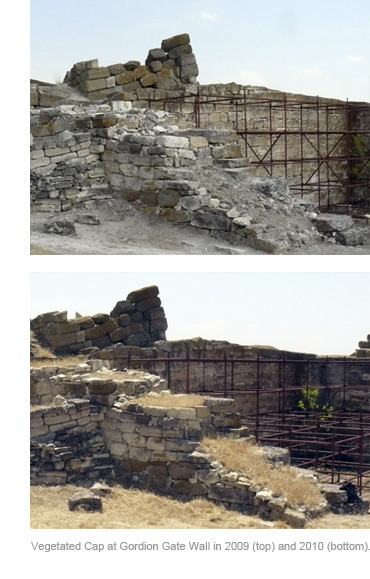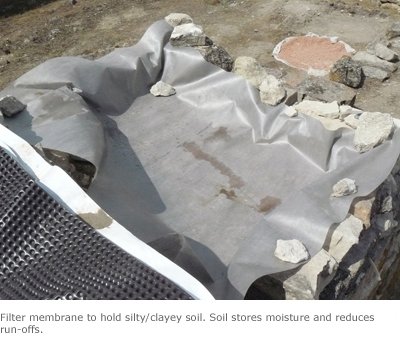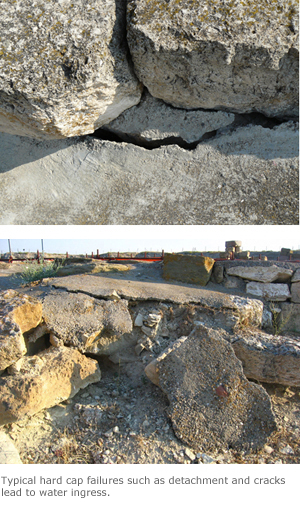 |
ACL Project List |
 |
Soft Capping The stabilization program at Gordion has been focused on remedying the adverse and often catastrophic effect of possible seismic events on the Gate wall. In order to improve the structural stability of the wall, traditional hydraulic lime-based grout mixtures were laboratory tested and injected into the joints and voids. (For more information, see Kelly Wong's thesis). After filling approximately one third height of the wall, the program was halted, based on the uncertainty of the grout penetration extent and the inability of the wall to effectively shed water from its core once filled with grout. In addition, exposed ruin walls are typically protected from water by hard caps of lime, amended soil and cement mortars. The hard caps eventually fail when cracks develop inviting water, plants and animals. The repeated repairs of these failed hard caps have been inadequate in the long term management of the sites as they are remedial and often exacerbate water-related damage through entrapment, dissolution, and ice and salt crystallization.
"Soft" capping utilizing vegetation, soil/gravel and geosynthetics offer an effective and sustainable alternative to traditional hard capping. Ongoing laboratory and field research at an archaeological site of Gordion, Turkey aims to protect the exposed masonry walls from environmental stresses and offer a more attractive alternative to hard caps. |
 |
|
|
Limits of Typical Hard CappingIn the past, a hard capping of lime, cement, and modified soil mortars has conventionally protected exposed masonry walls. This method has been popular due to its minimal intervention to the standing wall and the relative ease and economy of its initial application. In reality however, the procedure requires persistent repairs and maintenance that can increase cost and risk to the wall. Hard caps tend to crack under prolonged compressive and tensile stress from thermal movement and ground subsidence. Cracks allow easy access for water to further penetrate and concentrate inside the cavity. At the same time, the cracked cap retards drying and desorption of moisture from the top of the wall. Increased moisture can cause dissolution of core mortars or soil and damage the masonry through freeze/thaw cycling and salt damage, each of which eventually weakens a wall. In addition, the damaged cap must be replaced through the aggressive removal of the previously installed cap or if this is not done, repaired or capped over by a new one. In either case, hard capping does not usually adequately address the long-term management of moisture and thermal damage that will continue to stress the wall. Instead of protecting the compound wall as initially designed, hard capping can actually accelerate deterioration of the wall over time. |
Soft Capping: Alternative Capping TechniqueA procedure called 'soft capping' aims to counter such problems posed by hard capping. Introduced in recent years at several archaeological sites in England, Turkey and elsewhere, soft capping replaces hard caps with vegetation planted on top of a layer of soil, with optional layers of gravel, and geosynthetics. Taking advantage of soil and plants' evapotranspirative ability to utilize water, it seeks to prevent water penetration, reduce thermal fluctuations, and provide a protective barrier on the wall top. Geosynthetics provide further protection from moisture and temperature control. Often used in landfill waste control for their very low permeability of water and toxic solutions, geosynthetics provide a moisture barrier and drainage system, in addition to functioning as filter layers and soil support. Over the years, architects adopted geosynthetics for use in "green" roof technology in architecture while archaeologists used the material for reburial of sites. |
 |
| Use the arrows to scroll through photographs of soft capping |
